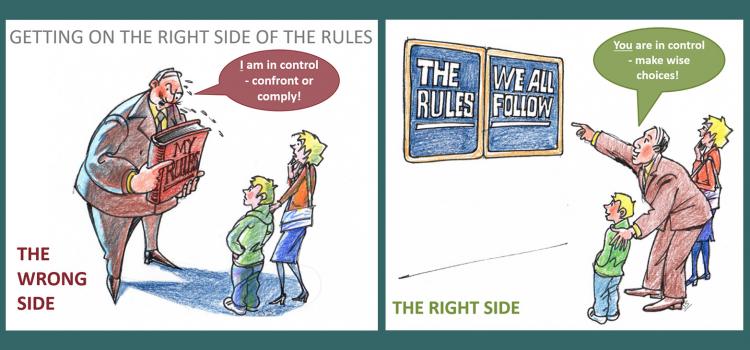
29
Oct
To persuade or to enforce?
We can only control – make choices about – our own behaviour, and try to guide the other person to make the right choices about their behaviour.
We are far more effective when we do this using the soft skills of persuasion and negotiation rather than trying to dominate every situation.
The soft skills of persuasion and negotiation
Control, authority and discipline are maintained using a mixture of relational techniques, good communications skills, and a willingness to engage in imaginative interpersonal transactions.
Teachers with soft skills are not ideologically committed to one style of response. They may be (within context) firm or flexible, patient or assertive, forgiving or determined, compromising or uncompromising … and so on.
The message children hear is
You are in control - make a choice!
(of course we mean ‘in control of yourself’)
Dominance and coercion
Teachers who apply a dominance style tend to over-control through regimentation, authoritarian but not authoritative, and hold punitive attitudes to wrongdoing instead of therapeutic attitudes to wrongdoers.
Teachers who use this approach are more likely to be pushed into handing out more sanctions, because unless children ‘obey’, there is nowhere to go except to up the ante with an additional sanction.
The message children hear is
You are bad - either confront me or comply!
Ideology or humanity?
Hardliners believe that the system will collapse if they ‘weaken’, but this view is not borne out by evidence from schools where all the staff use soft skills and there are few or no exclusions. Persuasive teachers understand that they no-one can ethically control another person, child or otherwise.
Soft skills teachers also understand that to develop motivation in a child, the child must make a voluntary choice to act. If you force anyone to do anything, there is a very high chance they will stop as soon as the force is removed. Making a child do something is not developing motivation.
So we can only control - make choices about - our behaviour and try to guide the other person to make the right choices about their behaviour.
What does this look like in the class?
An observer in such a class would see a teacher helping children
- experience a sense of choosing as much as possible
- benefiting themselves from what they are asked to do
- experience a sense of being in control
- have reasons to trust
They will see the children
- being given clear honest explanations and time
- being fully valued and involved as human beings
- being encouraged to make and value agreements
When we use a restorative approach to deal with breaches of the school code which lead to social harm we ask the children to show a similar respect for us as fellow humans.
Of course, if they have never seen our human side, and only ever seen the teacher-face that is harder for them.
Soft skills teachers also know that showing their human face builds trust and creates opportunities for children to share their feelings in a safe way and ask for help in the right way.
If you haven’t read this article – it follows on…
Comments
Copyright and usage
The content of this article may be used only for non-commercial purposes under the following conditions
.1 Teaching children or training staff in-house
The content must be acknowledged as the work of Dr Adam Abdelnoor
Any resources used should be used unedited or altered in any way.
2. For other non-commercial activities
The content must be acknowledged as the work of Dr Adam Abdelnoor
Any resources used should be used unedited or altered in any way.
Any quotes references or other usage should be attributed to the author and cited as follows:
Dr Adam Abdelnoor, 2018, The relational approach: user guide and manual (submitted manuscript)
